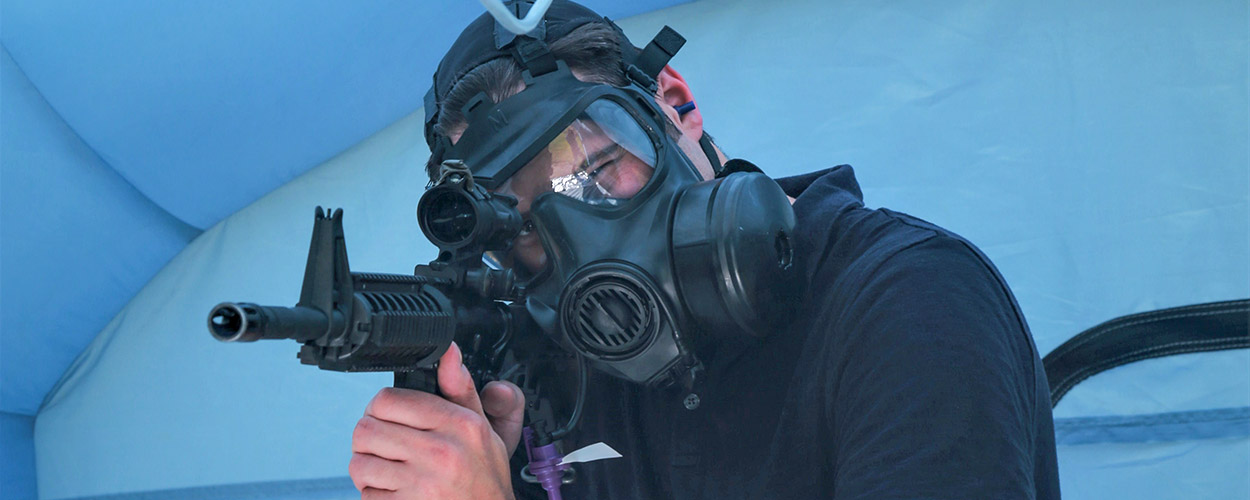Mobile Test Chamber Eases Challenges for Conducting Gas Mask Tests
Mobile Test Chamber Eases Challenges for Conducting Gas Mask Tests
By Shawn Nesaw
Protection factor (PF) testing allows the U.S. Army and other military branches to determine how effective chemical biological protection masks are during use by warfighters. During a test, warfighters don their protective masks, step into a test chamber and are put through a series of movements while aerosol simulants are pumped into the chamber. Each mask receives a score based on how effective it was at protecting the wearer from the simulant. With protective masks in use in all branches of the military, in different parts of the world, conducting protection factor tests is a challenge for researchers when it comes to shooting a weapon while wearing a gas mask.
Steven Yurechko, a chemical engineer at the U.S. Army Combat Capabilities Development Command (CCDC) Chemical Biological Center, decided it was about time to provide a solution to the challenges he and others face when attempting to conduct these types of protection factor tests with the most critical challenge being a way to provide a uniform, consistent aerosol challenge.
Yurechko needed a way to conduct live-fire tests from inside a test enclosure while maintaining the correct concentration of aerosol simulant to ensure proper test results. The enclosure also had to be mobile enough to easily transport to firing ranges or other customer test sites.
Yurechko looked to what was readily available, an off-the-shelf, inflatable paint spray booth.
“It inflates just like a bouncy house you see at a kid’s birthday party,” Yurechko said. “We installed custom ventilation ports into the interior of the chamber so that aerosol simulant can be pumped into the chamber directly through the blower which is used to inflate it. This ensures uniform aerosol concentration throughout the interior which meets the joint service standard for conducting protection factor testing.”
The interior directional air ports concentrate the simulant toward the back of the chamber where the test subject stands while the front chamber door can be fully opened to allow for rifle fire without damaging the enclosure.
After performing extensive chamber mapping tests to confirm that the aerosol dispersion met the current joint service standard for testing, Yurechko then took the inflatable chamber and the scientific instruments needed to conduct a protection factor test to Aberdeen Proving Ground to prove that his inflatable test chamber concept could easily be set up and would actually work for a live fire test.
“The whole set up fits in three ruggedized cases and one of those cases doubles as a table to organize the testing devices,” Yurechko said. “Setup took a total of about 10 minutes with two personnel. Inflating the chamber itself took less than a minute.”
Accompanying Yurechko down range was a group of Center researchers willing to don a gas mask and fire rounds down range from inside the chamber.
“We had concerns that the expended bullet casings would be hot enough to damage the nylon interior of the chamber, causing it to collapse,” Yurechko said. “We installed protective fabric panels in areas we thought a casing might hit or become lodged which helped, but overall, even casings that did come in contact with the chamber didn’t damage it.”
Pleased with the overall performance of the chamber, Yurechko is already busy making improvements to the mobility and form factor of the test setup as well as improvements to the data acquisition system.
Yurechko has already received positive feedback from colleagues and interest from several organizations eager to put the portable test chamber to use.
If live-fire testing isn’t necessary, the enclosure can also act as a mobile, stand-alone PF chamber. For some tests, customers require that actual end users of the masks act as test subjects.
“Until now, conducting a test was a slight logistical nightmare due, in part, to scheduling travel for multiple warfighters to come to the Static PF Test Facility at CCDC CBC where the test was being held,” Yurechko said. “It was time consuming and expensive for the Army.”
Zach Chadwick, a chemist at the Center, was recently supporting protection factor testing for pilots of the Rotary Wing Program which was conducted at the Static MIST Facility at the Center.
“This new test chamber that would have been ideal for our purposes because it travels easy and we can take it to the pilots instead of having them come to us,” Chadwick said. “The portability factor alone makes this a worthwhile capability, but then you add on the option to test masks while actually firing rounds down range, something that up to this point hasn’t been reliable, and you’ve got something special.”
Funding for the project came from the Center’s Fiscal Year 2019 Innovative Development of Employee Advanced Solutions Program designed to give researchers with promising new ideas seed money to develop them. It was one of eight projects chosen from a field of 17 to receive funding.
A civilian researcher fires rounds down range from within the inflatable chamber to test the chamber’s ability to properly contain aerosol simulant during a live-fire exercise. (Photo by Shawn Nesaw)

